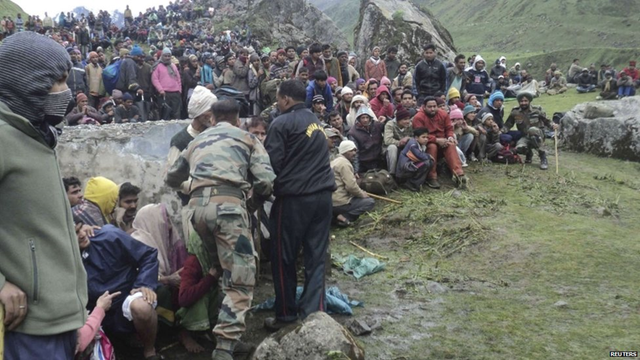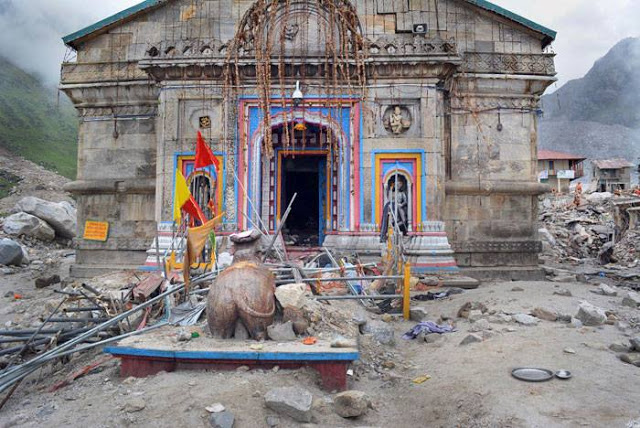Floods in India leave devastation akin to an inland tsunami – The government ‘angered Lord Shiva, and a few hours later there was cloudburst and floods’
[Somehow missed posting this back in July, but Des definitely wants to keep this story.] By Dr. Manpreet Bajwa and Dr. Harman Boparai
6 July 2013 LACHMOLI, India (Global Post) – Ninety-year-old Sarita’s sunken eyes stared into the damp earth that had flooded into the terrace of her one bedroom house. Her two grandchildren played nearby in the mud. Sarita’s only son had gone to the Kedar valley to work during the busy pilgrimage season. Two weeks after the disaster, she had no news from him. Lachmoli had been cut off. Only a small dirt footpath enabled residents to trek to safety and seek supplies. Her daughter-in-law had passed away a few years earlier, potentially making this frail, wrinkled elder the family’s only remaining adult. “Who will take care of [the children]?” she mumbled as we distributed food to the children. “I don’t know if my son is alive or dead.” Throngs of villagers remain uncertain of their loved ones’ fate, after the June 16 flashfloods killed nearly 1,000 people and left 3,500 missing here in Uttarakhand state, near the Nepal border. The disaster prompted a major air rescue operation, with the Indian Army evacuating more than 100,000 people from Himalayan valleys. Resulting from the heaviest rains in 80 years, the floodwaters wrecked more than 150 bridges and close to 1,500 roads in the state, according to official figures, leaving villages like Lachmoli inaccessible to relief efforts. Drinking water, electricity and communications were badly damaged. An estimated 658 villages remained in darkness two weeks after the disaster. The response to the floods has highlighted the state’s lack of preparedness, and underscored the urgent need for better infrastructure, coordination and communication between government bodies. The Indian home ministry admitted the lapses and told a Parliamentary Committee last Monday that a national flood risk mitigation scheme had been rejected in January because it missed vital components. A medical relief team of eight doctors and paramedics from New Delhi visited the area in late June. After lengthy negotiations, two soldiers agreed to take us to Rudraprayag, the town where the Alaknanda and Mandakini rivers meet. The roads were under repair and open only for a few hours. As we traveled, rivers swollen by monsoon rains surged alongside, a reminder of the force that had swept away entire communities. It took four hours to navigate the 90-minute journey through the villages. Further uphill, the roads were completely gone. In the villages of Devimanda and Mahar Gaon, on the banks of the river Alaknanda, the majority of households had washed away. Lacking electricity, with ruined homes and lost families, the few remaining residents bore an almost ghostly look. Tears swelled in their eyes as they told us how they saw loved ones and houses swept away in the angry river. “It was like Lord Shiva was doing his Tandav” said one, talking of the Hindu god Shiva, or the Destroyer, who in Hindu mythology performs his divine dance to destroy a weary universe. In the villages of Silani Gaon, Jagathi and Chamm, we listened to the complaints and needs of the people. Some felt ignored by local authorities and neglected by relief efforts. Upon returning to Rudraprayag, we informed the authorities about the conditions in those villages. They said that they were doing their best with the limited resources they had, pointing to problems of access and communication. The biggest challenge, they said, was to deliver essentials — rations, clothes, fuel and chlorine tablets — to remote areas where people were stranded. […]
For the locals, the floods were more than just a natural disaster. A priest told us that the government had angered the Gods and brought this disaster upon the people. According to legend, he said, the Char Dham pilgrims were protected by Dhari Devi (an avatar of the Hindu goddess Kali Mata). However, the idol had been shifted from its original place in view of the Hydel Power Project. “This angered the Devi and Lord Shiva, whose one form is Kedarnath, and a few hours later there was cloudburst and floods,” he said. He added that a king in 1880’s had made a similar attempt, which with similar results. Many locals and religious leaders had strongly opposed the shifting of the idol. [more]
June’s flash-floods in Uttarakand, India leave devastation akin to an inland tsunami


sigh. So moving an idol caused all this … is it a waste of time trying to get people to understand cause and effect (even if indirectly this can be seen as connected)
So sad to here about it. We have to be caution on the situations and also take extra measures to avoid such a destruction's. I used to chant durga mantra in order to bless them with normal life again.